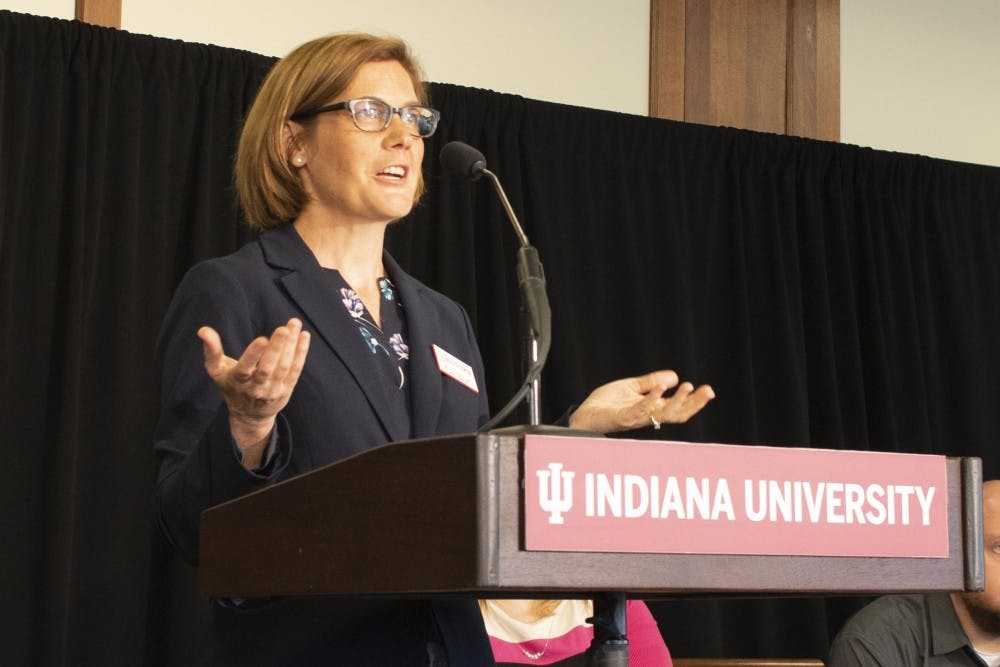IU’s mumps outbreak has grown to 20 cases as of April 22, Beth Rupp, medical director for IU Health Center, said.
The first case was diagnosed Feb. 12, and an outbreak was declared by the Indiana State Department of Health on March 12 after three cases were documented.
Officials from the Indiana State Department of Health and IU spoke Monday about the mumps outbreak.
Rupp said 17 cases were diagnosed at the center and three of them were diagnosed at an outside facility.
Sixteen students have recovered and returned to classes, while three cases are still in quarantine. No students currently have major complications from the infection, she said. Many of the students were immunized.
There had been 19 cases of mumps, and the 20th was confirmed a few minutes before the press conference began. Because of this, Rupp’s numbers are based on 19 cases of mumps.
Two of the students were international students, while the other 17 were domestic, she said. Seven students were dormitory residents.
Rupp said last week an average of three to four tests were performed per day, and the center is expecting more cases.
In 2016, 74 cases of mumps were reported at IU. In 2017, 17 were reported and none were reported in 2018.
The telltale sign of mumps is swollen salivary glands, though many students will experience other symptoms akin to the flu, Rupp said.
Graham McKeen, public health manager for IU Environmental Health and Safety, said one area for the mumps outbreak has been an on-campus fraternity house. Some of the cases have come from house members and others from exposure.
The fraternity isn’t being identified because the university doesn’t want students to target the fraternity or feel as if they have a false sense of security if they haven’t been to its house, Rupp said.
If students were exposed to mumps through dormitory living, classes or close contacts, they will be notified via email, she said.
It is important for students to report if they think they have the mumps so people they came in contact with can be notified and the patient can be monitored, Rupp said.
McKeen said his department provides guidance and coordination with different governmental agencies during outbreaks.
Public safety advisories are sent out by his department. One was sent to notify students of the first case and then another one when an outbreak was declared, McKeen said.
McKeen said a webpage has been set up to keep people updated on prevention tips, case count and general information about the virus.
Students with confirmed cases in dormitories have been given single rooms with single bathrooms. All floormates have also been notified, McKeen said.
Members in the unnamed fraternity have been notified as well. The fraternity has suspended all social activity for the rest of the semester, McKeen said.
McKeen said vaccination documentation is required for students attending IU. However, state policy allows students to self-report vaccination records, which means this documentation doesn’t come from a medical provider. In outbreak situations, self-reported documentation isn’t allowed.
Only a handful of students are exempt from vaccinations, and most come from religious exemptions. McKeen said the outbreaks are not stemming from those students.
Pam Pontones, Indiana State Department of Health deputy health commissioner and state epidemiologist, said students aren’t recommended to get a booster shot unless extenuating circumstances occur.
According to the Centers for Disease Control and Prevention, a telltale sign of mumps is puffy cheeks and a swollen jaw. The disease could also lead to loss of appetite, fever, headaches, muscle aches and fatigue.
Symptoms of mumps generally appear more than two weeks after infection, and people with mumps typically recover in about two weeks, according to the CDC.
Mumps most commonly affects unvaccinated people in a close-contact setting such as a college campus, according to the Mayo Clinic. There is no specific treatment for the viral disease, and it’s highly contagious for about nine days after symptoms begin to appear.




